Archive for Real Estate
Lawn Treatment Basics
Lawn Treatment Basics Maintaining a healthy lawn can be an overwhelming undertaking for anyone. You have to find and use the correct fertilizers, pesticides, and treatments to control weeds and keep bugs at bay. If left untreated, your yard can turn into an eyesore due to the brown patches and out-of-control weeds. With the help of a landscaping professional, this does not have to be the case. Here are a few lawn treatment basics that you need to know to keep your turf green and healthy throughout the year.
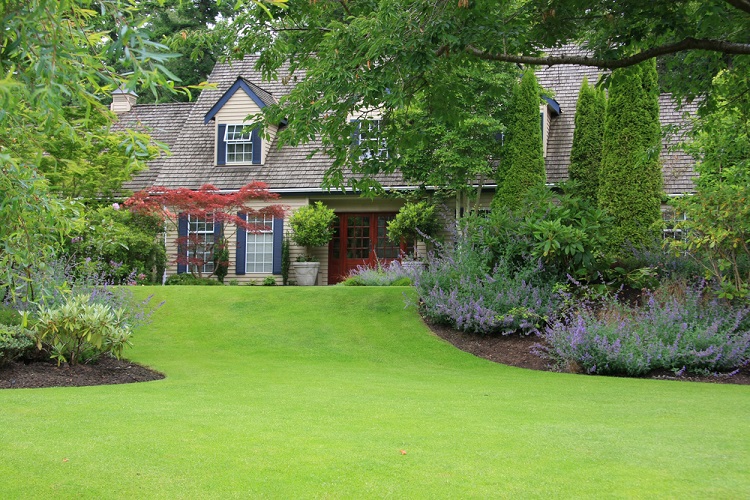
What is Lawn Treatment?
Lawn treatment refers to a series of tasks to protect your lawn from pests and weeds and ensure healthy grass growth throughout the year. It may entail spraying, fertilizing, dressing, watering, and mowing the grass to make sure it remains damage-free all year round.
As the grass on your lawn grows, it will likely attract all sorts of weeds and plant-eating pests. Pest invasions and uncontrolled growth of weeds may wreak havoc on your landscaping, leading to brown patches and stunted grass.
Applying various treatments correctly and appropriately can help save your lawn from dying and ensure it remains green and lush just the way you want it.
Types of Lawn Treatment
As you already know, lawn treatment involves several activities to help keep your grass healthy and vibrant. The four main types of lawn treatment you should know about include:
Fertilization
The soil on your lawn may not provide all the nutrients required for healthy growth. For this reason, consider adding fertilizer to your yard to help promote foliar and root growth. You have the option to use either commercial or natural fertilizer formulated for that particular season.
Make sure the fertilizer contains vital nutrients such as nitrogen for foliar growth and phosphorous for root growth. If you prefer organic fertilizers, consider using compost or natural ingredients like blood meal and meat meal.
Pest Control
Well-maintained lawns are not immune to pests and insects. No matter how healthy your lawn seems, it will still attract all sorts of bugs and insects such as beetles, sod webworms, crickets, fire ants, chafer grubs, fairy rings, and liverworts. It may also attract millipedes and rodents like moles.
Without proper interventions, lawn pests can cause tremendous damage to your landscaping in the long term. You can use various lawn treatments such as pesticides and insecticides to keep these bugs at bay.
Weed Control
You will notice unwanted plants growing on your lawn after a few weeks or so. These weeds can wreak havoc on your yard as they will be competing with your grass for nutrients.
Fortunately, with the correct weed control treatments, you can prevent these unwanted plants from growing in the first place and eradicate those that have already started growing. Pre-emergent herbicides destroy weeds before they start growing, while post-emergent herbicides eradicate already established weeds.
Disease and Fungus Treatment
Brown or dead patches on your lawn are a sign of disease. Lawn diseases usually result from fungus, poor lawn care practices, excessive mowing, overwatering, humidity changes, temperature fluctuations, drought, and excessive use of fertilizers.
The good news is that you can tackle different lawn diseases using various treatments. Fungicides come in handy when treating fungus, while you can mitigate environmental causes by applying the appropriate lawn care techniques.
Benefits of Lawn Treatment
The benefits of lawn treatment are almost countless, and they include:
Root Development
Using the correct lawn treatments will help develop a solid and healthy root system for your grass. The grass will set firm roots in the ground, making it hard to uproot or erode through natural processes.
Even Distribution of Nutrients
The soil in your lawn may not have all the nutrients required for healthy plant growth. Fertilizing your yard will make sure the grass receives all the vital nutrients for healthy growth. Fertilization also ensures the even distribution of nutrients across your lawn.
Disease Resistance
Your lawn may experience various diseases caused by environmental factors and pests. Even though lawn diseases are common, you can make your turf less vulnerable by applying proper treatments.
Pest Resistance
Your lawn will inevitably attract all sorts of bugs and insects ranging from crickets to chafer grubs. Fortunately, you can boost your lawn’s resistance by spraying various treatments and pesticides.
Soil Conservation
Lawn treatments promote healthy growth and protect the soil from environmental stressors such as drought and runoff. They also help improve the soil’s composition by adding missing nutrients such as phosphorous, nitrogen, and potassium.
Weed Control
One of the most significant benefits of lawn treatments is weed control. Using the correct treatment will keep weeds from your lawn, subsequently ensuring the grass does not have competition for vital nutrients.
Hire a Lawn Treatment Expert
Knowing when and how to treat your lawn is vital for healthy grass growth. You must know when to fertilize, weed, and spray to keep bugs and weeds at bay. A wrong schedule can cause tremendous damage to your lawn, leading to dead and brown patches.
Our experts at DK Landscaping can help schedule your lawn treatment appropriately and ensure your yard remains lush and healthy throughout the year. Contact us to learn more about our services.
Tips for the Best Sprinkler System Design
Your sprinkler system is essential for keeping your yard lush and healthy. When you invest in the best sprinkler system, you reduce your water usage and the time you spend tending your lawn. Here are some tips for the best sprinkler system layout for a hassle-free, flourishing yard.
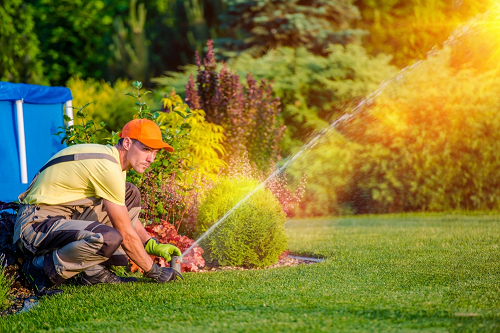
Determine the Size of Your Yard
Knowing the size of your yard is the first step in designing your sprinkler system. The yard size determines the size of your sprinkler system, the number and types of pipes, valves, manifolds, controllers, and the number of nozzles to use. When measuring your lawn, include the driveway, walkways, outdoor sheds, and your house.
Measure the Water Pressure
Your local water authority can give you a report on your property’s water pressure. But since the pressure may vary from one point across your yard to the other, measure the water pressure and gallon per minute from different locations. Hook a water gauge to an outdoor spigot, and then turn it on fully to detect the water pressure.
Measure the gallons per minute( GPM) water flow in your property by placing a gallon under a tap and recording the time it takes to fill up with water when you turn on the tap to full blast. The water pressure and GMP determine if there will be sufficient water flow in your sprinkler system to irrigate your yard.
If the pressure is low, you may need to operate sections of the sprinkler system separately. This is not a problem since the sprinkler sections serve areas with different watering needs.
Determine Your Hydrozones
Different parts of your property have varied watering requirements based on the soil type, type of plants, and shade covering. Shady areas require less watering than the areas that receive sunlight all day.
Besides, native plants may need less water, the same way clay soil needs less water than sandy soil since it holds water better. These hydro zones will help you set different watering frequencies on your sprinkler system.
Draw Your Sprinkler System Layout
Determine the layout of your piping, nozzle heads, valves, and irrigation controller. Draw your sprinkler system design on graph paper to a scale to ensure your measurements are accurate. This will tell you the number and size of fitting you require.
Select Your Sprinkler Heads
Pick sprinkler heads from the same brand since each brand designs sprinkler heads differently. You may need different sprinkler head designs to suit your hydro zones. Here are sprinkler head designs to consider:
- Spray Heads with Rotary Nozzles
They are ideal when spraying a large area. They can consistently sprinkle water to a radius of about 13-30 feet.
- Rotors
Fix the same size of rotors in each hydro zone for consistency. The rotor head size will depend on the area and radius you want it to reach. They can deliver water to 15 feet to 50 feet radius.
- Fixed Spray
Fixed sprays reach a radius of about 6 to 18 feet, with each sprayer delivering water to the same area consistently. Arrange your fixed sprayers to ensure a subsequent sprayer begins where its predecessor ends.
- Specialty Patterns and Bubblers
These sprayers deliver water to special landscapes areas such as lawn end strips, shrubs, and trees. They can throw water as high as 15 feet and up to 5 feet radius.
- Drip Irrigation
This sprinkler system consists of many small emitters that deliver water directly to a plant. They are laid on the ground in landscape beds and ground covers.
Acquire Your Sprinkler System Parts
Buy your sprinkler system parts from the same brand to ensure they integrate well. Ensure you pick the correct sizes and types for each hydro zone. You will need pipes, nozzle heads, manifolds, irrigation controllers, and valves.
Layout Your Sprinkler System
Follow your design sketch to lay out and join the sprinkler parts for each hydro zone. You can use common valves for small nozzle heads. You can also connect several valves to one controller.
Test and Adjust
Once you have assembled your sprinkler system, test if the sprinkler system layout works as expected. Note any anomalies and rectify them.
Test if the sprinkler system delivers water concurrently to all the parts of your yard or there are parts where the water pressure is insufficient. Some parts of the sprinkler may deliver water well when operated individually if they are affected by low water pressure and GPM.
Set your controllers appropriately to meet the watering frequency needs for each hydro zone. To get the best out of your sprinkler system layout, work with lawn experts with experience in designing, laying out, and maintaining sprinkler systems.
Are you looking for a reliable landscape maintenance company to help you with your sprinkler system design? Reach out to us. We will test your water pressure and GPM to determine the best sprinkler system parts and layout.
We will also help you identify your hydro zones for the best sprinkler system layout. Contact us today to discuss your landscape maintenance project.
Small Backyard Ideas for a Magical Outdoor Space
Well-designed outdoor spaces can increase your enjoyment of your home. But what if you have a small backyard? Well, the good news is you don’t need a sprawling estate to transform your backyard into an outdoor oasis. Thoughtful landscape design can transform your small patio or yard into a refreshing outdoor space.
Transform Your Home with these Small Backyard Ideas
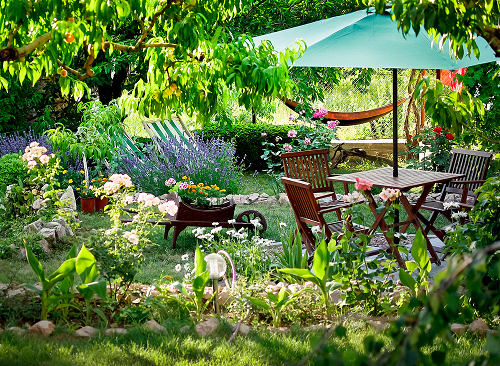
Whether you live in an apartment, townhouse loft, or a house with minimal outdoor space, you can carve out an outdoor space for yourself. Yes, even modest balconies and rooftop terraces count. Even a small yard can feel grand if you design it the right way.
Here are some small backyard ideas that can help you maximize the little space you have.
1. Create a Container Garden
You may not have the space or time to become a master gardener, but you can learn to create striking container gardens. When you lack good soil, containers allow you to make the ideal conditions for your plants to thrive.
All you need is a planter, some potting soil, and the plants of your choice. From hanging baskets to window boxes, you can embellish your backyard with bold foliage for a refreshing space your friends and family will love.
2. Think About Vertical Space
Vertical gardens, or living walls, are ideal features for small spaces. Think of the magnificent living tapestries that ornament public gardens and some buildings. You can bring the same beauty and vitality into your home using vine-covered trellises, closely planted fruit trees, and decorating your walls with hanging plants.
Reinvigorating your exterior with a living wall brings your backyard to life, attracting songbirds and pollinators, and can help temper the summer heat. Living walls also act as art, establish boundaries within a landscape, give you a sense of privacy, and obscure undesirable views.
3. Create a Focal Point
Focal points are used in landscape design to draw and direct the eye. If your backyard consists of a swath of plants or is crammed with furniture, your eyes will sweep along the area, not knowing where to land.
If your backyard is filled with plants and feels more like a garden, you can use a statue or a small fountain to detract some attention from the plants. You can also strategically place furniture to draw in the eyes. Conversely, if your space is adorned with furniture, you can use a large plant as a focal point.
4. Use Every Inch – Even the Side Yard
The side yard is often overlooked and can easily become a sad spot adorned with nothing but unsightly air-conditioning units. You can perk up your side yard by adding a stepping-stone path or install a welcoming entry gate if your space allows.
Another way is to draw the eyes up, away from the sides, using arbors, hanging vines, or strategic overhead lighting.
5. Embrace a Multi-Level Landscape Design
Breaking up your yard with steps, decks, retaining walls, or terraces can create the illusion of a larger backyard. A multi-level design helps to break things up visually, and you can help you separate the different functionalities of your yard.
You can have a dining patio on the upper level and incorporate different greenery into the lower levels.
6. Create a No-fuss Patio or Deck
Don’t have a green thumb? Not to worry. You can set up a murphy bar or an al fresco dining room on a bed of gravel, and voila! You added a little polish to your backyard. Add some statement chairs to create a laid-back or rustic atmosphere depending on the vibe you’re going for. And don’t forget to add some hanging lights to elevate the mood at night.
The idea here is to create a warm, welcoming space that doesn’t require you to get your hands dirty.
7. A Small Kitchen and Dining Area
Love to grill? You don’t necessarily need a large space for this. You can create an outdoor cooking center. All you need is a little space for a basic grill, counter, and a small dining area. You can even add to the ambiance by adding a fireplace or a small garden.
For your family, this could mean growing herbs in the garden, cooking dinner outdoors on the weekends, and enjoying evenings by the fire.
8. Maximize on Available Space
When you have a small backyard, it’s best to create a multifunctional space. You can invest in some portable furniture that you can keep in your basement or garage when not in use. Or, you can create seating benches that also double as storage spaces for lawn games and plants.
Better yet, you can build a mini storage shed that’s cute yet functional.
Revitalize Your Backyard
Looking for small backyard ideas that make a statement? DK Landscaping can help you create the backyard of your dreams. We are a full-service maintenance company with the tools and expertise to help you create a flourishing landscape.
Contact us today! The solution to your lawn and garden woes lies with us.
Tips for a Healthy Landscape Maintenance
Healthy soil is the key to a healthy lawn and landscapes, so you need to follow the proper tips for landscape maintenance for which you need to consider mowing, planting, pruning, and hosting the other tasks. If you are mowing your lawns offer, then these can cause various problems, and if you are more dependent on irrigation, then these can cause damages to your landscape plants that also cause a host of diseases. How about your trees; have you ever wondered what you can do to make them look better? It’s easy to take care of your trees with pruning, but if these are done poorly, then your trees can become weak and susceptible to storm damage and disease. Here are some of the key lawn and landscape maintenance tips to keep your property beautiful and healthy –
Mowing

You need to keep your lawn at the right height throughout the year, and it is imperative due to which people go with over-mowing for keeping their lawn perfect. However, if you always look for the different ways to keep your trees healthy, then you need to take care of the mowing process, and you need to consider how often it needs to be done. Mainly, over-mowing can damage the crown of the grass, but if you are doing it too short, it can burn the roots so you should use the stable method. You should avoid mowing your grass more than 1/3 of the existing glass blade as when you, it can shock the plants, especially when the outside is much hotter. If you are cutting grass too short, then you need to water them regularly, and when the plants are not good, they attract more pests and diseases.
Planting
Planting the trees and shrubs are most effective for keeping the plants healthier for long when you are following the landscape maintenance process. Most plants are planted when with their growing crown even with the soil line or just above it, so when planting trees, plants get into the native soil in a hole as deep as the root balls and twice as wide.
Weeding
Some weeds grow unnecessarily, and those mainly affect your lawn look, so you need to learn various things about your landscape maintenance that mainly includes soil for the type of weeds you are growing on your property. If you want to control weeds to improve your soil and landscape health, then you can use the hand-removal technique to keep everything in good shape.
Watering
It will help if you water your landscapes and gardens, which are the most crucial elements to keep your landscape in good condition. If you are over-watering your lawns, then these can cause fungal diseases and pest infection, whereas if you are watering too little, then it can affect your landscapes while attracting pests. It is necessary to have a rainfall of 1-inch per week with the irrigation system as it is a good way to figure out the right amount of watering the landscapes. When it is hot in the summer, you can increase the duration of the watering times for efficient landscape maintenance.
Inspect
When it comes to landscape maintenance, you need to keep it healthy while spending more time on it, so you need to look closely for the defects in your plants and the improvements they need. While inspecting your plants, you can notice the pests or disease before they become a bigger problem due to which inspecting can become the best defense against pests and diseases.
Even if your lawn is healthy, you need to feed them with the recommended fertilizer as these can keep your gardens in good shape, while enhancing the look of your landscape. The unwanted weeds can affect your healthy grass, so you need to use reliable tips for banishing those unwanted weeds. Furthermore, no matter which plant you are using for your landscape, climate plays an essential role in determining the type of grass that can work best for your landscapes. So, whenever you think about landscape maintenance, you need to consider the soil type, rainfall, and other factors that can severely impact the look of your landscape. Contact us for more information.
Irrigation Installation for Corporations
Irrigation installation involves meticulous planning and setting up a layout that can consistently provide water for a landscape area. Corporations and establishments are responsible for taking care of their lawns as long as the business is up and running. It is quite tedious to get a steady source of water for landscapes, especially in an area that is short of water supply. Also, some plants need adequate water, while others do not require much because of their ability to conserve water. An administrator of a corporate entity needs to understand and install irrigation according to the needs of the lawn plants and the office location. Corporations have responsibilities to handle, so administrators should hire a lawn care specialist that can assist them with the irrigation process.
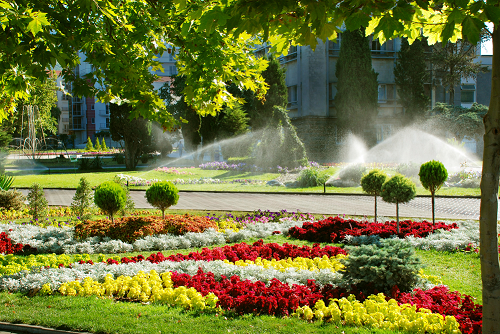
To deploy an irrigation system, the manager, the representative of the firm, and the supervisor of the installation company will come together to discuss how the project will pan out. The process usually begins with examining the site topography and establishing where the service provider will install the water meter. The service provider is also responsible for laying out the design and setting up the plumbing part of the project. With the aid of technology, one can design an irrigation system that suits a landscape with a computer software package. The design must show where the power source, valves, mainlines, sublines, sprinkler heads, and other peripheral connections.
The service provider should be able to advise the corporation on the best method of irrigation for your lawn. When we have to consider expenditure, sprinkler irrigation systems are more expensive than drip irrigation because of the plumbing work and automated controlling unit. In 2020, a sprinkler system requires an average cost of $3000 or more per one-quarter of an acre of land, while a drip method requires a lesser budget of $2000 per acre of land. So, an administrator may intend to choose the subsurface drip method based on cheap quotation; however, if one considers the benefit of control and flexibility which sprinkler method offers, then he/she may decide to opt for the latter. Lawn care specialists prefer to harness this method due to the two reasons listed. Drip irrigation is not ideal for lawn maintenance, but it will help to sustain the growth and lushness of flower beds and shrubbery.
Besides, the supervisor of the installation project can adopt hydro zoning for the sprinkler system. Hydrozoning is a way of segregating plant species based on the quantity of water they need to survive. So, the lawn expert cultivates each plant species together to form an assemblage. Then, the sprinkler directs the water to each plant cluster so that the plants will generally have sufficient water. Contact us for more information.
Inspiring Landscaping Ideas for your Front Yard
Every homeowner dreams of a lush and colorful garden in their front yard. While upgrading the front yard with striking landscaping ideas can boost the appeal of any home, it also needs a lot of inspiring ideas for skillful execution.
You can enhance the appeal by settling for the right edges, flowers, shrubs, and plants to complement the aesthetics of your home. Before beginning to design your front yard, create an inventory of the space available. Because there are numerous ideas, decide on the one that best suits your space.
1. Lighting
If you believe your home is a masterpiece, then your landscaping becomes the stage you want to proudly display in a luminous halo. Because every stage has its footlights, your front yard alike needs perfect illumination.

From scene stealing fixtures to subtle accent lighting and canopy to flood, you are sure to find the right option for every style. Inlaid lights for instance show off your landscaping ideas while antiquated lamp-style lighting direct your visitors to your front door after dark.
2. Accent Color Tree
An accent color tree can magically transform your yard by adding seasonal color, scale, shade, and overall structural interest. Choose a species that work for your climate, personal preference, and the design of your landscape.
Going for a small tree with bold colorsto offer your home strong visual appeal. A flowering cherry for example gives the best highlight during spring while a Japanese maple creates vibrant foliage color in autumn.
3. Urns
Classic urns go beyond holding flowers, cremated ashes, and wine, among others. Today, these curvaceous structures are used for many styles as decoration items especially in the front yard.
Large urns add carb appeal by popping color to the garden and serving as fountains. Whether you choose to fill them with plants or leave them empty, urns can be a powerful art element with endless textures, glazes, and forms.
4. Omit the Lawn
Even if you live in an evergreen environment, you can still omit the lawn to create a unique landscape. Avoiding a lawn means you will not spend too much time maintaining it. It means enjoying your outdoor living space in all seasons.
When planning your front yard landscaping, pay special attention to the entrance to ensure it is clear and inviting. Unique structures, plants, trellis to block the wind or rain can do the trick. Remember that every façade has a visual asset and liability. A properly and creatively done front yard goes to highlight the strong points and mask the unattractive ones. Take these landscaping ideas to give your home the highlight it deserves. Contact us for more information.
Discovering the Best Flower Bed Ideas for Your Home
Flower bed ideas are typically broken down one of two ways – by the color(s) that you’re going to be using and, secondly, by the kinds of materials you might use to bring your flower ideas to life (e.g., wheelbarrow flower beds).
Monochromatic Flower Beds
Monochromatic is a blend of two words – mono, which means one, and chromatic, which refers to color. Monochromatic flower beds are designed from blooms that are all the same color.
A monochromatic flower bed can add a splash of color to your outdoor landscape, and the thing to bear in mind is that, although everything will be one color, you can use various shades and textures to create a stunning effect.
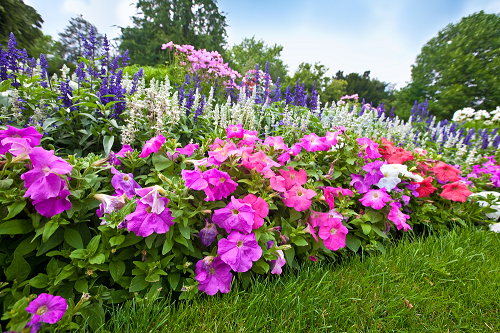
Purples and yellows are very popular variations when it comes to monochromatic flower bed ideas.
With a purple monochromatic flower bed, you have a lot of beautiful flowers to choose from: lavender, sage, leather flower, hydrangea, and grape hyacinth. A walkway lined with lavender can be absolutely breathtaking.
A yellow color scheme is also a popular choice for monochromatic gardens. Yellow gardens let you blend in deep golden hues with paler flowers with an almost buttery accent.
The Denver Daisy – a.k.a., Black-eyed Susan – and marigolds are great for adding deeper shades of yellow to a backdrop of a more mellow flower like the annual nasturtium.
Keep in mind that blues, whites, and violet flowers will have a more calming effect in your garden whereas warmer colors like red and yellow can create instant excitment!
Dichromatic and Ombre Flower Bed Ideas
Dichromatic means two colors wheras ombre is a French word that means you’re going to be using a blend of colors that gradually blend in to each other.
If you only want to use two colors, with varying shades of each color, then you probably want to look into a dichromatic garden. You’ll also want to consider using contrasting yet complementery colors to create the most powerful aesthetic look.
If you’re feeling more adventurous, then an ombre flower bed might be the way to go. Ombre flower beds typically blend some of the cool hues and warm hues discussed above to gradually blend in flowers with a lighter hue with dark hues.
An ombre flower bed typically starts off with a walkway made of flowers of a cooler, softer hue so that the eye gradually gets more and more captivated with the darker tones at the back of the garden.
Wheelbarrow Flower Garden
Sometimes called wheelbarrow planters, a wheelbarrow flower garden can be made using a wheelbarrow that’s rusted-out, cracked, or has a broken wheel.
The wheelbarrow, though, should have holes in the bottom to allow excess water to drain out. The big benefit to a wheelbarrow flower garden is that you can move it to an area with more sunlight.
Walkway Flower Beds
As alluded to above, a walkway flower bed can be a wonderful segue into a captivating garden or a landscaping effect all its own.
Millions of homeowners have already beautified their homes with a walkway flower bed culminating with their front door.
Walkway flower beds actually touch on a difference with gardens in general – a walkway flower bed would be an example of a formal garden path with right angles and straight lines.
That said, a walkway flower bed could open up into an informal pathway kind of garden (the second type) where you would have a meandering or curved path. A crescent-moon type of garden in the front yard would be an example of this second type.
Which flower bed ideas appeal to you most? Contact us for more information.
Rock Garden – It’s More Than What Meets the Eye
Contrary to popular opinion, there is more to a rock garden than a garden filled with rocks. In reality, it is a blend of plants and rocks complimenting each other.
Unlike easterners, mainly Japanese who use rock gardens to find enlightenment, we in the west are more focused on creating beautiful spaces that are a pleasure to look at and relaxing.
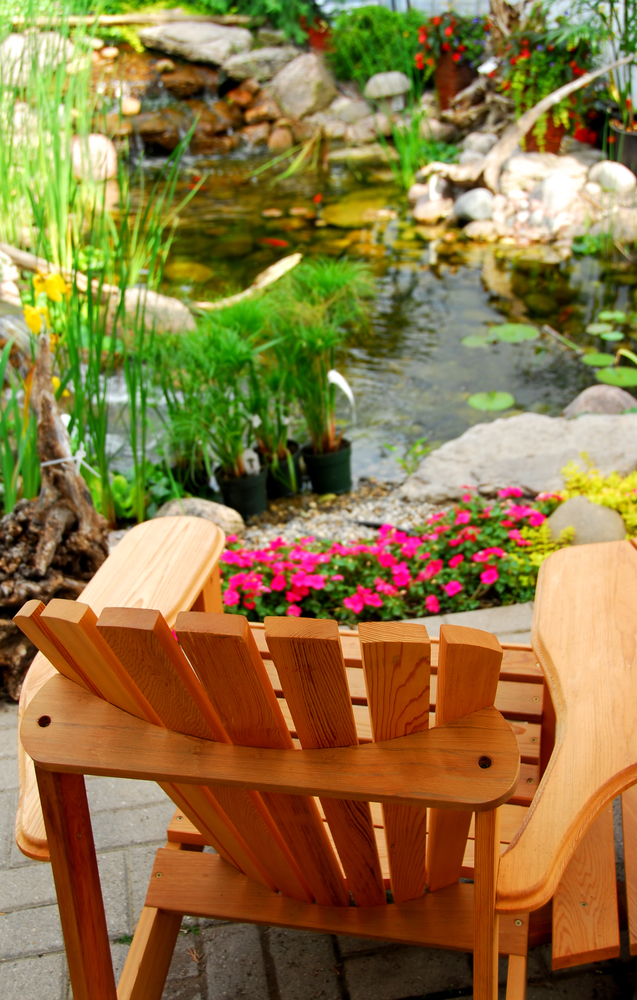
Before we get into how you can use the rocks, here are some few benefits of having a rock garden.
- First, these gardens can survive harsh climate. You can throw anything at them from extreme winters to sweltering heat, and they will endure. Strong winds or droughts will no longer be a concern.
- They are low maintenance. Unlike customary gardens, these are easy to maintain as they don’t require frequent feeding, watering, mowing, aeration, or control of pests. Moreover, the rocks can be placed around the plants to control weeds reducing the need for chemical control. They are ideal for people who lead busy lives.
- Also known as Zen gardens, you will appreciate that they look great all year round. However, you should use a combination of plants that bloom in spring and summer together with evergreens and fall foliage.
- Rocks allow you to create depth and diversity by combining tiny pebbles with large boulders.
- Rocks also create the illusion that your yard is large. Seeing as you use fewer plants than traditional yards, you create the perception that your yard is extensive.
How you can use rocks around the garden
You can use different stones to create a specific impact depending on what you want.
First, if you are looking for ambiance or a casual, laid-back garden, an area you can sit and relax; we recommend beach pebbles or river rocks. These add warmth, are pretty inviting, and are customizable seeing as they are available in various sizes and colors.
You can also use rocks to control weeds. Place them around your plants and flower beds, and fill up those empty spaces between plants as mulch.
You can use white marble chips to create a cheerful and bright space. They are especially useful in shady areas as their bright color will contrast with the dark soil and general ambiance there. You can also use dark marbles to balance out a bright area.
A rock garden will come in handy if you have a steep slope or uneven surface. Some of these spaces are difficult to mow and maintain. However, you can use rocks to transform it into a showcase of more delicate plants.
You can also use stones to create a border around your ponds. They are great for camouflaging the liners and creating contrast with the water for a dynamic look.
Conclusion
Rock gardening can give you a sense of sophistication and class. It is rare but beautiful, and the rocks and greenery compliment each other superbly.
However, it takes expertise to create a terrific rock garden. There is a ton of technical knowledge and experience required, and we encourage you to hire professional landscapers. You can contact us to book an appointment for garden maintenance, irrigation, water saving landscape design, and rock gardens. Contact us for more information.
Improve the Appeal with these Simple Lawn Treatment Tips
Every homeowner dreams of a perfect lawn. Unfortunately, only a few yards in residential areas are green, lush and healthy. This can be attributed to the lack of adequate care. In simple terms, if you do not put some time and effort into protecting, preserving and enriching your lawn, you will not get beautiful and thriving turf. Under ideal circumstances, you should engage a professional for yard maintenance. If you are set on DIY upkeep, use these simple lawn treatment tips for better results.
Check Your Mower Settings
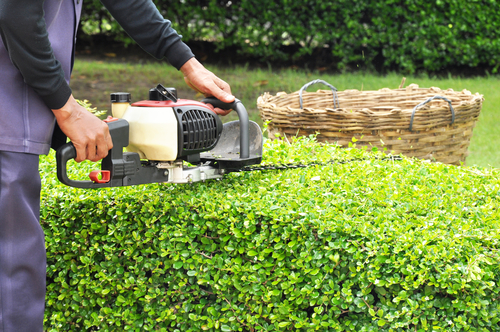
If your grass is growing healthily but the effect after mowing is not stunning, it is advisable to consider the lawn mower settings. Setting the blades to cut the grass to short can be highly detrimental to the beauty of the yard. You should note that different species of grass have optimal cutting heights. Consult your landscaping expert on the best length for your grass. Otherwise, you will have to deal with bald patches, poor root systems and even drying plants. When mowing, ensure that the mower blades are sharp, and alternate the cutting patterns for long-term lawn appeal.
Water at the Right Time
Watering your grass is an essential practice for a healthy lawn. Unfortunately, irrigating the plants at the wrong time can cause unexpected harm. For instance, if you water the grass in the evening, the moisture will remain on the blades for a prolonged period. This can promote the growth of harmful fungi on your property. On the other hand, watering when the sun is blazing prevents optimal absorption due to evaporation. Therefore, you should irrigate during early mornings for maximum absorption without the moisture overload.
Rake the Fallen Leaves
Raking the lawn is not fun for most people. However, if you want to keep your yard and grass in the best condition, this practice is necessary. When dead leaves are left on the lawn for too long, they will suffocate the grass and prevent the penetration of sunlight. Consequently, the grass will no longer have the lush green look. In addition, leaves promote moisture retention, and this will increase the risk of fungi attack. So, plan for the timely removal of dead leaves to protect your lawn.
Deal with Bald Spots
Bald spots can develop on the lawn due to unexpected problems. For instance, if you have not upheld the best mowing practices, some areas of the yard will look a little bare. Also, poor soil aeration and smothering of grass by objects can cause bald patches. It is important to deal with these spots to restore the beauty of the lawn. The most convenient method for dealing with bald patches is filling in with a repair mixture. Typically, the repair material consists of suitable grass seeds, special fertilizer and in most cases, some organic mulch.
Finally, you should preserve the beauty of your lawn by controlling weeds. These unwanted plants will take away the nutrients intended for your plants. As a result, the grass will not grow healthier over time. Also, weeds are unappealing and will compromise the harmony of the turf. Therefore, you should plan for immediate weed removal if you notice any signs of invasion. Contact us for more information.
Outdoor Space Improvement: Simple Garden Ideas for Beginners
Establishing a garden on your property can be highly beneficial. In general, a home garden can be used for growing consumable produce or decorative plants. You can make your property more beautiful by planting flowers and other appealing plants in your garden. Alternatively, you can choose to plant vegetables, herbs and fruits. You will have access to fresh produce at a low price. It is possible to combine both categories of plants for a perfect garden.
If you are new to gardening, you might find starting the process challenging. Here are some basic garden ideas and simple guidelines for a smooth beginning.
Understand Your Environment

It is essential to learn more about your environment before starting the gardening work. If you are knowledgeable, you will increase the rate of success from the beginning. For the best results, choose a perfect spot on your property to start a garden. The spot should have adequate sun exposure. Too much or little sunlight will damage plants. It is also advisable to check the condition and properties of the potential gardening soil. Once you understand the specific characteristics of your garden, you can choose the most suitable plants to match the unique environment.
Consider Container Gardening
If you do not have enough space on your property, consider choosing container gardening. This one of the most beneficial and popular garden ideas in the modern home environment. You will be able to enjoy flowers or produce even with limited space. In addition, container gardening gives you more control. For instance, it is possible to grow any kind of plant because you can prepare unique soil material and move the container to different places for optimal environmental conditions. If you decide to take up container gardening, consider taking advantage of space on your patio, deck and rooftop.
Look into Vertical Planting
Most people opt for garden plants that remain close to the ground. If you are interested in a fresh idea for your home, think about growing some vertical plants. As implied, vertical planting involves establishing plants which grow upwards by climbing onto fences, stakes or trellises. This type of gardening can help you maximize your limited space. It also creates unique aesthetics in the home. In addition, this is the perfect gardening choice for people who might find squatting and bending difficult.
Choose Seeds or Starter Plants
Once you have decided on your ideal gardening style, you can begin choosing plants for your project. When selecting the perfect plants, it is advisable to keep your environment in mind. Some vegetables, herbs and flowers will not thrive in certain environments. Therefore, opt for plants which can grow with ease in your home. You will also need to choose whether to acquire starter plants or seeds. For a beginner, starter plants or seedlings are the most suitable. This choice will eliminate your worries about sprouting. On the other hand, seeds are cheaper, and you will find diverse plant species.
Utilize Companion Planting Methods
Consider utilizing a companion planting technique in your garden for better results. This approach is perfect if you would like to have a mixture of plants on your space. Companion gardening involves planting different complementary species of plants together so that they will benefit from one another. For instance, if you are planning on growing vegetables, you can plant carrots alongside leeks. The lees will repel harmful carrot flies. Note that there are some plants must not be planted together. If two species are affected by the same diseases and pests, avoid planting them together. Contact us for more information.





